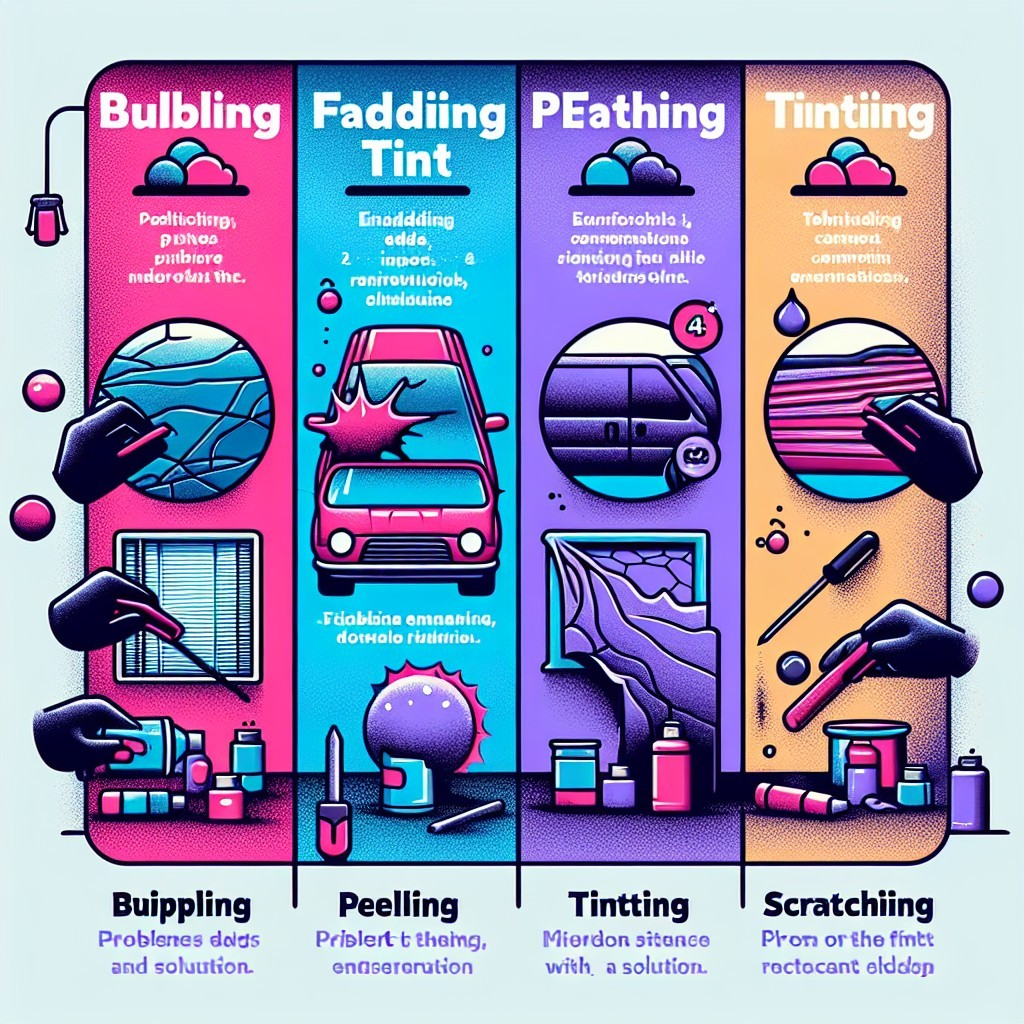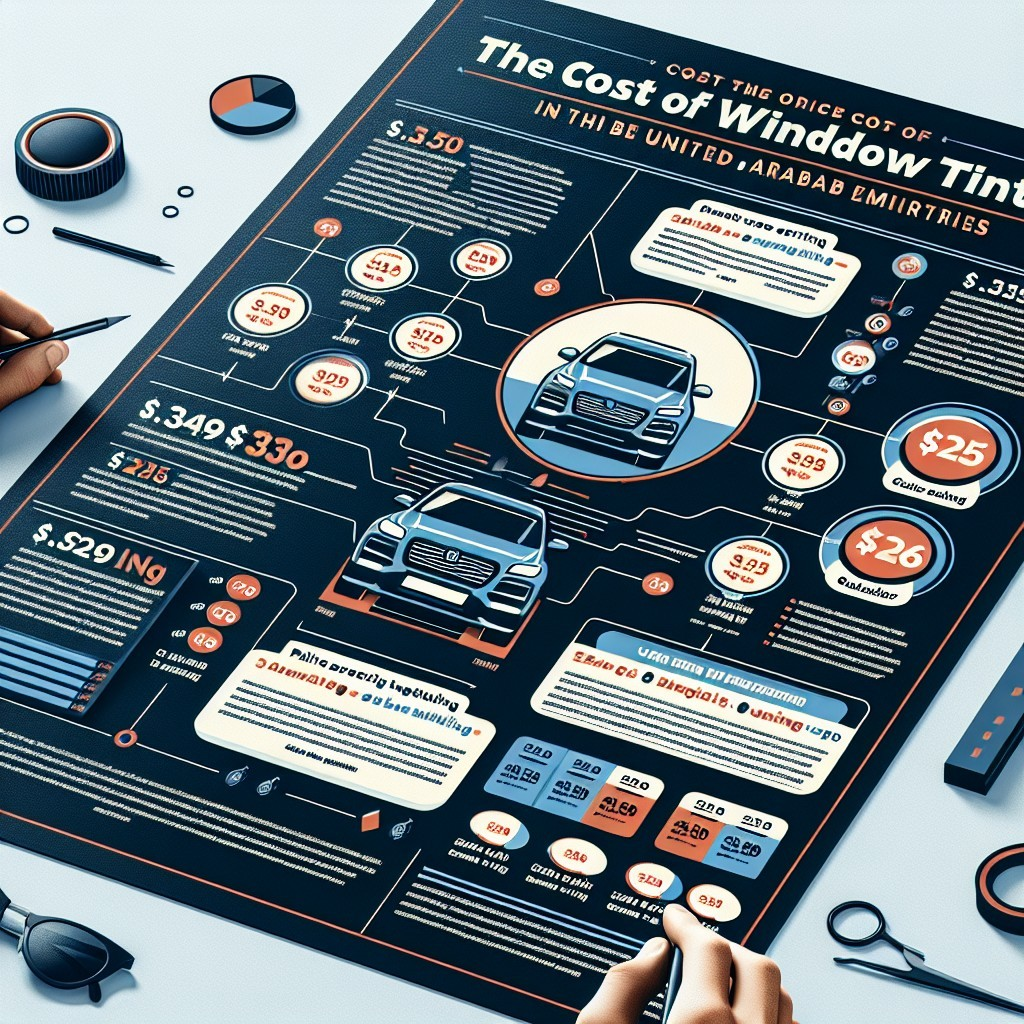Tinting your car windows can enhance the appearance of your vehicle, improve privacy, and protect the interior from harmful UV rays. However, achieving the perfect tint job can sometimes lead to a few common problems. Whether you’re a DIY enthusiast or you’ve had your windows tinted professionally, it’s essential to know how to address these issues effectively. Here, we explore five common tint problems and provide solutions to help you fix them.
1. Bubbles Under the Tint
One of the most noticeable problems with window tinting is the appearance of bubbles. These bubbles can form if the tint is improperly applied or if moisture is trapped beneath the film. Not only are they unsightly, but they can also affect visibility.
How to Fix:
- Wait it Out: Sometimes, small bubbles will disappear on their own as the adhesive cures. This process can take a few days to a week.
- Poke and Smooth: If the bubbles persist, you can use a small needle to puncture them gently. After puncturing, use a credit card covered in a soft cloth to smooth out the area, pushing the air towards the puncture.
- Heat Application: Use a heat gun or hairdryer on low heat to warm the film and surrounding area. This can help the adhesive bond better and eliminate bubbles.
2. Peeling Edges
Over time, the edges of your window tint may start to peel away from the glass. This can happen due to improper application, exposure to extreme temperatures, or using low-quality tint film.
- Reapply the Tint: For small areas, carefully trim the peeling section with a razor blade and reapply adhesive. Ensure the surface is clean before reapplying.
- Replace the Tint: If peeling is widespread, it may be best to remove the old tint and apply a new film entirely. This ensures a fresh, clean finish.
3. Color Fading
Over time, window tint can fade due to prolonged exposure to sunlight and UV rays. This fading can lead to an uneven appearance and diminish the effectiveness of the tint.
- Choose Quality Film: To prevent future fading, invest in high-quality, UV-resistant window film when replacing the tint.
- Full Replacement: Unfortunately, once the tint has faded, the only solution is to remove the old tint and install a new film.
4. Scratches on the Tint
Scratches can occur due to improper cleaning techniques or accidents. Scratches not only look bad but can also cause distortion in visibility.
- Use a Scratch Repair Kit: Some kits are specifically designed for window film and can help reduce the appearance of light scratches.
- Replace the Film: For deep scratches that do not improve with a repair kit, consider replacing the affected section of the film or the entire window tint.
5. Mismatched Tint Shades
If you’ve had your windows tinted in stages or if different windows were tinted by different shops, you might notice a mismatch in shades. This inconsistency can be visually jarring and detracts from your vehicle’s aesthetic.
- Uniform Tinting: The best solution is to have all windows tinted at the same time by the same professional to ensure a consistent look.
- Replace Mismatched Sections: If you can’t redo all the windows, you might consider replacing the mismatched sections with a tint that closely matches the original.
While window tinting can enhance your vehicle’s appearance and functionality, issues can arise. Understanding these common problems and knowing how to fix them can save you time and money, ensuring your windows look their best. Whether you choose to tackle these issues yourself or seek professional help, addressing tint problems promptly will help maintain your vehicle’s aesthetic and protective qualities.
Remember, regular maintenance and choosing quality materials are key to avoiding future tint issues. Happy tinting!
As we delve deeper into the world of window tinting, it’s essential to understand not just the problems that can arise but also the broader context of why these issues matter and how they can be prevented in the future. Tinting is not merely a cosmetic upgrade; it’s a blend of art and science, offering practical benefits alongside aesthetic appeal. Here are some further insights into maintaining your window tint and ensuring lasting satisfaction.
Understanding the Science Behind Window Tint
Before tackling the issues of tint, it’s crucial to grasp the technology behind it. Window tints are made from various materials, including dyed, metalized, ceramic, and hybrid films. Each type has its advantages and disadvantages, influencing factors like durability, UV protection, and heat rejection. Understanding these differences can help you choose the right tint for your vehicle, thereby minimizing the risk of problems down the line.
Choosing the Right Tint
- Dyed Film: Provides privacy and visual appeal but may fade over time.
- Metalized Film: Offers excellent heat rejection and durability but can interfere with electronic signals.
- Ceramic Film: The premium choice, it blocks heat and UV rays without interfering with signals and does not fade.
- Hybrid Film: Combines the best aspects of dyed and metalized films, offering a balanced solution.
Tips for Tint Maintenance
Once you have installed your tint, maintaining it becomes key to prolonging its life and appearance. Here are some expert tips to keep your tint looking pristine:
- Avoid Harsh Chemicals: Use only mild soap and water when cleaning your tinted windows. Harsh chemicals can break down the adhesive and damage the film.
- Use Soft Cloths: Microfiber cloths or soft sponges are ideal for cleaning. Avoid abrasive materials that can scratch the tint.
- Wait Before Washing: If your tint was recently applied, give it at least a week before you wash the windows to allow the adhesive to fully set.
- Protect from Scratches: Be mindful of how you handle items in your vehicle, especially near tinted windows, to prevent scratches.
When to Seek Professional Help
While many tint issues can be resolved at home, certain problems are best left to the professionals. If you notice extensive peeling, significant bubbling, or fading that affects visibility, it may be time to consult with a tint specialist. They possess the tools and expertise to ensure a flawless application and can often provide warranties on their work.
Window tinting is an investment that requires thoughtful consideration and care. By understanding common problems, selecting the right materials, and maintaining your tint properly, you can enjoy the benefits of tinted windows for years to come. Whether you’re seeking privacy, UV protection, or simply a sleek look, being proactive can help you mitigate issues before they arise, ensuring that your vehicle remains as stylish and functional as you envisioned.
So, the next time you think about tinting your windows or face an issue, remember: knowledge is your best ally. Embrace the science, embrace the art, and drive with confidence!
Understanding the Nuances of Window Tinting
Window tinting is more than just an aesthetic choice; it’s a blend of functionality and style that can elevate your vehicle’s appeal while providing essential benefits. As you embark on or continue your window tinting journey, it’s crucial to grasp not just the process but the nuances that come with it. Here are some insights to help you navigate the world of tinting more effectively.
The Importance of Professional Installation
While DIY tinting kits are available, the importance of professional installation cannot be overstated. Professionals possess the expertise to ensure that the tint is applied evenly, minimizing the likelihood of common issues such as bubbling and peeling. Furthermore, they have access to higher-quality materials that can enhance the longevity and effectiveness of the tint.
Understanding Local Regulations
Before proceeding with any tint application, familiarize yourself with local laws regarding window tinting. Regulations can vary significantly from one region to another, dictating allowable tint percentages and reflective levels. Complying with these laws not only keeps you on the right side of the law but also ensures that your vehicle maintains its resale value.
Enhancing Your Tint Experience
Once your windows are tinted, there are several ways to enhance and prolong the life of that fresh application:
- Consider a Ceramic Coating: Adding a ceramic coating over your tint can provide additional protection against scratches and UV damage, further preserving its appearance.
- Invest in Quality Cleaning Supplies: Use specialized window cleaning solutions that are safe for tinted surfaces. This prevents degradation and ensures clarity.
- Regular Inspections: Periodically check for any signs of wear or damage. Early detection of issues can make repairs easier and less costly.

Future Trends in Window Tinting
As technology advances, so too does the world of window tinting. Here are a few trends to watch out for:
- Smart Tint Technology: Innovations are leading to tint films that can change opacity with the touch of a button, offering customizable privacy and light control.
- Eco-Friendly Films: As sustainability becomes a priority, look for tint options made from environmentally friendly materials that do not compromise on performance.
- Enhanced Heat Rejection: New developments in film technology are paving the way for even better heat rejection properties, making your vehicle cooler and more comfortable.
Whether you’re a seasoned tint enthusiast or a first-timer, the journey into window tinting offers numerous avenues for enhancement and exploration. By understanding common problems, opting for professional installation, and keeping abreast of new technologies, you can ensure a satisfying and lasting tint experience. Remember, a well-tinted window is not just about looks; it’s about making a statement while ensuring comfort and protection on the road.
So gear up, dive into the world of window tinting, and make your vehicle truly yours!


This guide has saved me a lot of hassle! I never knew how to handle fading or peeling before.
Thanks for sharing this! The tip about using a microfiber cloth is a game changer. My windows have never looked better!
The section on peeling edges was particularly useful. I’ll definitely try these tips!
I love how you emphasized using distilled water! It makes such a difference in keeping my tinted windows clear.
I had no idea bubbles could be fixed so easily! Thanks for the practical advice.
This article is a must-read for anyone considering window tinting! The tips on fixing common issues are super helpful.
I love how this article breaks down common issues with window tinting. Very informative!
The step-by-step process is easy to follow. I’m excited to try out the vinegar solution for my car windows!
Great insights on window tinting problems. I appreciate the detailed solutions provided!
Great article! I had no idea that cleaning in direct sunlight could cause streaks. I’ll definitely adjust my cleaning schedule.
‘So informative! The advice on not spraying directly on the window was exactly what I needed to know.’
Fantastic read! The heat application method for bubbles is something I’m excited to try.
‘This article is a lifesaver! My tinted windows were always streaky, but now I feel confident about cleaning them properly.’